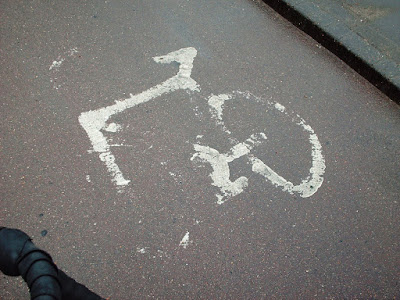 Folly Lane 27/02/11.
Folly Lane 27/02/11..
Rule 19 for pedestrians, in The Highway Code:
19
Zebra crossings. Give traffic plenty of time to see you and to stop before you start to cross. Vehicles will need more time when the road is slippery. Wait until traffic has stopped from both directions or the road is clear before crossing. Remember that traffic does not have to stop until someone has moved onto the crossing. Keep looking both ways, and listening, in case a driver or rider has not seen you and attempts to overtake a vehicle that has stopped.
Rule 195 for motorists, in The Highway Code
195
Zebra crossings. As you approach a zebra crossing
•look out for pedestrians waiting to cross and be ready to slow down or stop to let them cross
•you MUST give way when a pedestrian has moved onto a crossing
•allow more time for stopping on wet or icy roads
•do not wave or use your horn to invite pedestrians across; this could be dangerous if another vehicle is approaching
•be aware of pedestrians approaching from the side of the crossing
A zebra crossing with a central island is two separate crossings (see Rule 20).
[Law ZPPPCRGD reg 25]
Motorists are obliged to slow down when approaching pedestrian crossings, and more so if there are pedestrians in close proximity to the crossings. This is safe, lawful and considerate driving. Unfortunately it seems motorists are increasingly not respecting this pedestrian right of way. If it is so that a motorist can have right of way if he/she/it is able to cover the distance between their vehicle and the crossing while keeping within the speed limit - even if there is a waiting pedestrian or one making the first step across - why have zebra crossings at all? Do away with these death traps and create pedestrian no go zones. To know, as a pedestrian, you have a right of way across a busy road is reassuring and enabling if not empowering.
More and more, I have seen pedestrians thanking motorists for stopping at zebra crossings. For heaven's sake don't. To thank a driver for stopping only adds to the autocultural abuse of the pedestrian and is contributing to an unjust sense of entitlement on the part of the motorist.
Why has the London Borough of Waltham Forest put a zebra crossing so close to the junction of Hall Lane and the North Circular/A406 - a location where motoring is likely to be more belligerent? Would it not be better to have a Pelican or Toucan crossing here?
An answer to this question might come in the form of an image of the muddied pedestrian ways of the council when providing for those in the community who chose not to drive

 I think it would be fair to say this path is excremental.
I think it would be fair to say this path is excremental.Over in Found Objects there is a hauntological blogger posting images of ghost signs - here is Lost and Found in E17's contribution to this ghostly and, in some places, ghastly dialectic.
.

















































